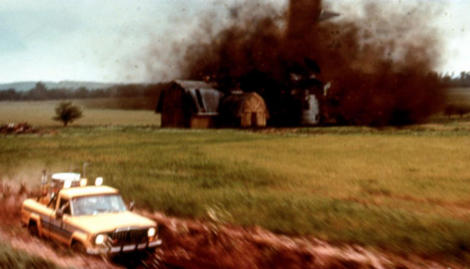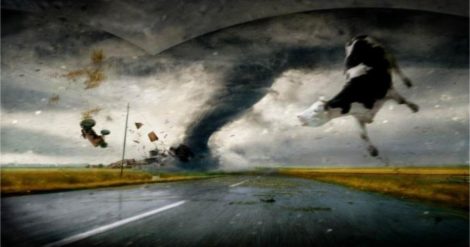Twister
Front Row at the Movies by Shirrel Rhoades
[mr_rating_result]A tornado is a destructive vortex of violently rotating winds having the appearance of a funnel-shaped cloud. Yes, that’s what blew Dorothy Gale’s house away in “The Wizard of Oz.”
Often referred to as a twister, whirlwind or cyclone, this violently rotating column of air can have wind speeds up to 300 MPH, stretch two miles across, and travel for dozens of miles on the ground, laying waste in its path.
 Their intensity is rated by the Fujita Scale, F0 being “light damage” up to F5 being “incredible damage.” At the F5 level, “Cars are mangled and thrown hundreds, possibly thousands of yards away. Frame homes, brick homes, and small businesses are swept away, trees debarked, corn stalks flattened or ripped out of the ground, skyscrapers sustain major structural damage, grass ripped out of the ground. Wood and any small solid material become dangerous projectiles.”
Their intensity is rated by the Fujita Scale, F0 being “light damage” up to F5 being “incredible damage.” At the F5 level, “Cars are mangled and thrown hundreds, possibly thousands of yards away. Frame homes, brick homes, and small businesses are swept away, trees debarked, corn stalks flattened or ripped out of the ground, skyscrapers sustain major structural damage, grass ripped out of the ground. Wood and any small solid material become dangerous projectiles.”
Tornadoes frequently occur in the central states from Texas to South Dakota; that swath is known as Tornado Alley. Meteorologists known as Storm Chasers follow these twisters to study them.
A thrilling look at storm chasers comes in “Twister,” the 1996 epic disaster film starring Bill Paxton and Helen Hunt. It’s playing at Tropic Cinema as part of the popular School’s Out series.
Here, we meet a meteorologist named Jo Harding (Hunt) who is trying to test a tornado forecasting device dubbed Dorothy. In the process, she meets up with her estranged husband Bill (Paxton), a former storm chaser turned TV weatherman. His fiancée in tow, he wants Jo to sign divorce papers, but they get caught up in an escalating series of storms – finally facing a terrifying F5 that they have to outrun on foot after deploying Dorothy. They survive by strapping themselves to pipes in an isolated pump station. Their marriage survives too.
No spoiler alert offered. You would guess the plot a few minutes into the movie. As Washington Post wrote at the time, “Characters exist merely to tell a couple of jokes, cower in fear of downdrafts and otherwise kill time between tornadoes.”
The film won Razzie Awards and Stinkers Bad Movies Awards for worst screenplay (Michael Crichton and Anne-Marie Martin) and worst supporting actress (Jami Gertz, as Bill Harding’s new fiancée).
 Despite all that, you’ll love the movie. What you’ll come for are the special effects. I remember my first time seeing the movie, I felt like I’d weathered an earth-shattering storm as I left the theater and stepped out into the day’s bright sunlight and cloudless blue skies.
Despite all that, you’ll love the movie. What you’ll come for are the special effects. I remember my first time seeing the movie, I felt like I’d weathered an earth-shattering storm as I left the theater and stepped out into the day’s bright sunlight and cloudless blue skies.
Entertainment Weekly reported, “Because overcast skies were not always available, De Bont had to shoot many of the film’s tornado-chasing scenes in bright sunlight, requiring Industrial Light & Magic to more than double its original plan for 150 ‘digital sky-replacement’ shots.”
As you might suspect (but soon ignore), the tornadoes in the film were all produced by CGI. The sound effects for the twisters were created by combining “lion roars, tiger growls, camel moans and jet engine wooshes.” A Boeing 707 airplane engine was used to generate wind effects.
The most memorable scene – the cow flying through the air – was concocted by using a CGI zebra from the 1995 film “Jumanji.” Other computer-generated objects included “telephone poles, trees, trucks, tractors and whole houses.”
Not surprisingly, Steven Spielberg’s Amblin Entertainment was behind the blockbuster film. Spielberg was supposed to direct it himself, but turned the task over to Jan de Bont (“Speed”). They paid Michael Crichton (author of “Jurassic Park”) and his wife $2.5 million to write the screenplay, basing it on a 10-page tornado-chaser story called “Catch the Wind” by Jeffrey Hilton. Warner Bros. and Universal put up about $90 million to make the film. A good bet, in that it has raked in half-a-billion dollars at the box office so far.
Email Shirrel: srhoades@aol.com


Ratings & Comments
[mr_rating_form]